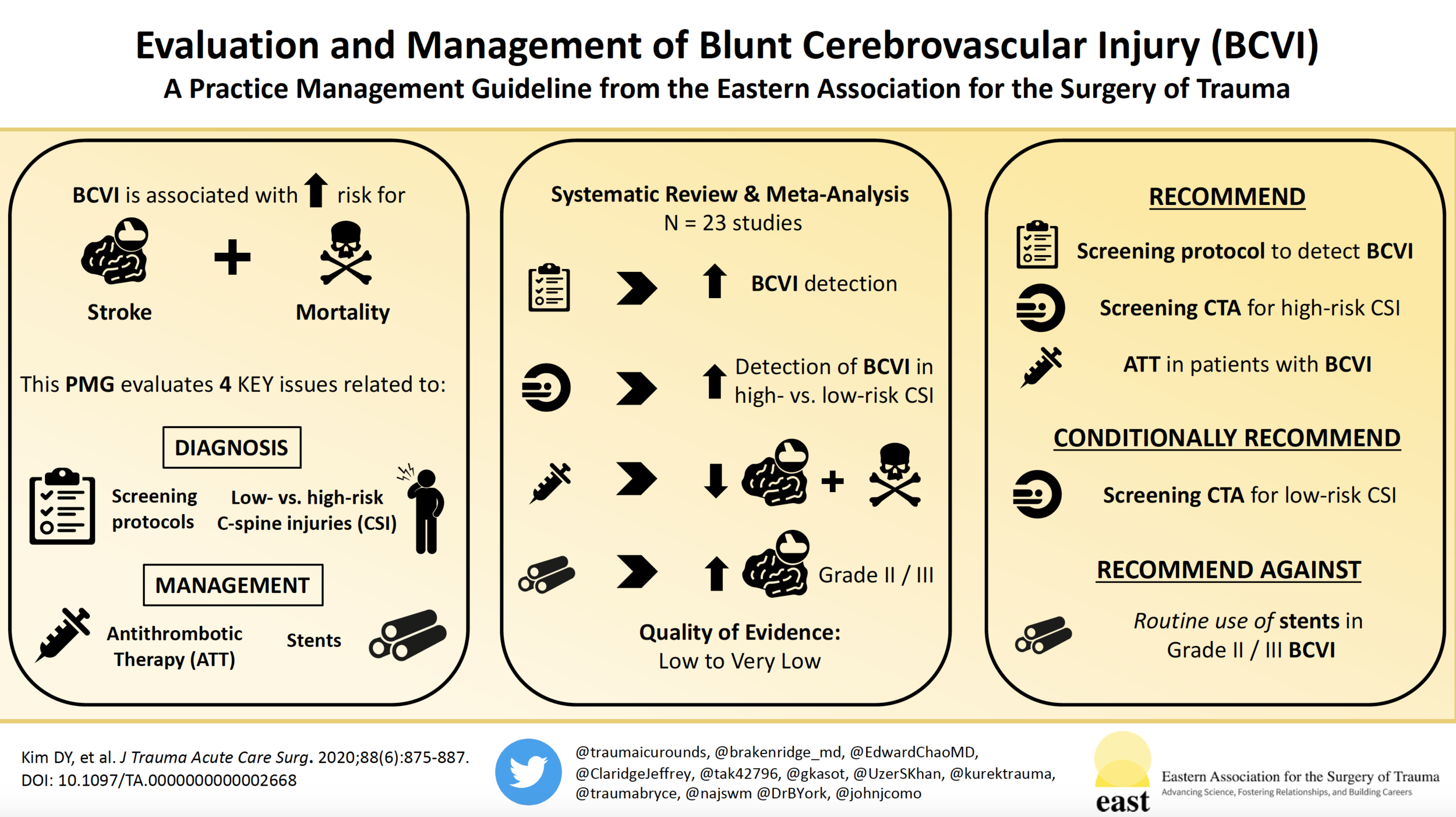Episode 32 - Blunt Cerebrovascular Injury (BCVI)
Learning Objectives
By the end of Rounds, you should be able to:
1. Discuss risk factors for BCVI on the basis of mechanism, associated injuries, and clinical exam findings.
2. Describe the complications associated with undiagnosed and untreated BCVI.
3. Understand the importance of early institution of antithrombotic therapy.
4. Describe key considerations for follow-up imaging and ongoing therapy post-discharge.
Take-Home Points
BCVI are much more common than originally described; the more you look, the more you find!
In general, it’s better to have a high-index of suspicion and low threshold to screen for BCVI
Universal screening of blunt polytrauma patients using high-resolution CT is an attractive option for patients already deemed to require a contrast-enhanced CT
In patients with competing injuries that could be worsened with the start of antithromobtic therapy (i.e., TBI, solid organ or spine injuries) EARLY multidisciplinary consultation regarding risks and benefits are paramount to optimal patient outcomes
Time Stamps
00:12 Introduction
2:37 “Right place, right time”; launching one’s academic career
4:56 The unrecognized epidemic of blunt carotid arterial injuries
5:30 Memphis & Denver Screening Criteria
06:05 Screening arteriography
07:00 What are the high-risk criteria?
08:38 From 4-vessel angiography to CTA
09:34 Making the case for universal screening
10:50 Expanded screening criteria
11:32 Mechanism & pathophysiology
13:40 Do all neck seatbelt signs require CTA?
15:42 Time to stroke
16:42 Diagnostic modalities - the role (or lack thereof) for Duplex and MRA
18:10 CT angiography - the new gold standard
19:59 BCVI in the pediatric population
22:08 BCVI Injury Grading Scale
25:48 Operative intervention for BCVI, few and far between
27:14 Antithrombotic therapy: decisions, decisions, decisions
29:44 Loading the boat
33:24 Dual antiplatelet therapy
34:40 Follow-up imaging: who, when, now what??
36:24 Management of BCVI patients with concurrent TBI, solid organ and spine injuries
38:50 Endovascular stents
43:07 Future research directions for BCVI
44:40 Duration of therapy
46:30 Key take-home points
47:26 Outro
Recommended Readings & Resources
Journal Articles
Biffl WL, Moore EE, Ryu RK, Offner PJ, Novak Z, Coldwell DM, Franciose RJ, Burch JM. The unrecognized epidemic of blunt carotid arterial injuries: early diagnosis improves neurologic outcome. Ann Surg. 1998 Oct;228(4):462-70. doi: 10.1097/00000658-199810000-00003. PMID: 9790336; PMCID: PMC1191517.
Biffl WL, Moore EE, Offner PJ, Brega KE, Franciose RJ, Burch JM. Blunt carotid arterial injuries: implications of a new grading scale. J Trauma. 1999 Nov;47(5):845-53. doi: 10.1097/00005373-199911000-00004. PMID: 10568710.
Biffl WL, Ray CE Jr, Moore EE, Franciose RJ, Aly S, Heyrosa MG, Johnson JL, Burch JM. Treatment-related outcomes from blunt cerebrovascular injuries: importance of routine follow-up arteriography. Ann Surg. 2002 May;235(5):699-706; discussion 706-7. doi: 10.1097/00000658-200205000-00012. PMID: 11981216; PMCID: PMC1422496.
Biffl WL, Moore EE, Elliott JP, Ray C, Offner PJ, Franciose RJ, Brega KE, Burch JM. The devastating potential of blunt vertebral arterial injuries. Ann Surg. 2000 May;231(5):672-81. doi: 10.1097/00000658-200005000-00007. PMID: 10767788; PMCID: PMC1421054.
Burlew CC, Biffl WL, Moore EE, Pieracci FM, Beauchamp KM, Stovall R, Wagenaar AE, Jurkovich GJ. Endovascular stenting is rarely necessary for the management of blunt cerebrovascular injuries. J Am Coll Surg. 2014 May;218(5):1012-7. doi: 10.1016/j.jamcollsurg.2014.01.042. Epub 2014 Feb 3. PMID: 24661857.
Cothren CC, Biffl WL, Moore EE, Kashuk JL, Johnson JL. Treatment for blunt cerebrovascular injuries: equivalence of anticoagulation and antiplatelet agents. Arch Surg. 2009 Jul;144(7):685-90. doi: 10.1001/archsurg.2009.111. PMID: 19620551.
Cothren CC, Moore EE, Ray CE Jr, Ciesla DJ, Johnson JL, Moore JB, Burch JM. Carotid artery stents for blunt cerebrovascular injury: risks exceed benefits. Arch Surg. 2005 May;140(5):480-5; discussion 485-6. doi: 10.1001/archsurg.140.5.480. PMID: 15897444.
Cothren CC, Moore EE, Ray CE Jr, Johnson JL, Moore JB, Burch JM. Cervical spine fracture patterns mandating screening to rule out blunt cerebrovascular injury. Surgery. 2007 Jan;141(1):76-82. doi: 10.1016/j.surg.2006.04.005. Epub 2006 Aug 28. PMID: 17188170.
Miller PR, Fabian TC, Croce MA, Cagiannos C, Williams JS, Vang M, Qaisi WG, Felker RE, Timmons SD. Prospective screening for blunt cerebrovascular injuries: analysis of diagnostic modalities and outcomes. Ann Surg. 2002 Sep;236(3):386-93; discussion 393-5. doi: 10.1097/01.SLA.0000027174.01008.A0. PMID: 12192325; PMCID: PMC1422592.
Geddes AE, Burlew CC, Wagenaar AE, Biffl WL, Johnson JL, Pieracci FM, Campion EM, Moore EE. Expanded screening criteria for blunt cerebrovascular injury: a bigger impact than anticipated. Am J Surg. 2016 Dec;212(6):1167-1174. doi: 10.1016/j.amjsurg.2016.09.016. Epub 2016 Sep 29. PMID: 27751528.
Fabian TC. Blunt cerebrovascular injuries: anatomic and pathologic heterogeneity create management enigmas. J Am Coll Surg. 2013 May;216(5):873-85. doi: 10.1016/j.jamcollsurg.2012.12.053. Epub 2013 Mar 18. PMID: 23518252.
Fabian TC, George SM Jr, Croce MA, Mangiante EC, Voeller GR, Kudsk KA. Carotid artery trauma: management based on mechanism of injury. J Trauma. 1990 Aug;30(8):953-61; discussion 961-3. doi: 10.1097/00005373-199008000-00003. PMID: 2388306.
Fabian TC, Patton JH Jr, Croce MA, Minard G, Kudsk KA, Pritchard FE. Blunt carotid injury. Importance of early diagnosis and anticoagulant therapy. Ann Surg. 1996 May;223(5):513-22; discussion 522-5. doi: 10.1097/00000658-199605000-00007. PMID: 8651742; PMCID: PMC1235173.
Practice Management Guidelines & Algorithms
EAST PMG
https://www.east.org/content/documents/east_visual_abstract_final.pdf
https://www.east.org/education/practice-management-guidelines/blunt-cerebrovascular-injury-evaluation-and-management-of
WTA Critical Decisions in Trauma
http://www.marshall-surgery.net/wp-content/uploads/2015/07/Western_Trauma_Association-Screening-for-and-Treatment-of-Blunt-Cerebrovascular-Injuries-jtrauma-2009.pdf
